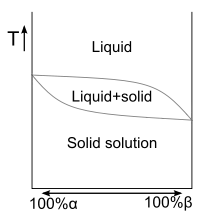Solid solution
A solid solution describes a family of materials which have a range of compositions e.g. AxB1-x and a single crystal structure. Many examples can be found in metallurgy, geology and solid-state chemistry. The word "solution" is used to describe the intimate mixing of components at the atomic level and distinguishes these homogeneous materials from physical mixtures of components.
Note 1: The definition “crystal containing a second constituent which fits into and
is distributed in the lattice of the host crystal” given in refs.,[1][2] is not general
and, thus, is not recommended.
Note 2: The expression is to be used to describe a solid phase containing
more than one substance when, for convenience, one (or more) of the substances,
called the solvent, is treated differently from the other substances, called solutes.
Note 3: One or several of the components can be macromolecules. Some of
the other components can then act as plasticizers, i.e., as molecularly dispersed
substances that decrease the glass-transition temperature at which the amorphous
phase of a polymer is converted between glassy and rubbery states.
Note 4: In pharmaceutical preparations, the concept of solid solution is often
applied to the case of mixtures of drug and polymer.
of polymers is small.[3]
In general if two compounds are isostructural then a solid solution will exist between the end members (also known as patents). For example sodium chloride and potassium chloride have the same cubic crystal structure so it is possible to make a pure compound with any ratio of sodium to potassium (Na1-xKx)Cl by dissolving that ratio of NaCl and KCl in water and then evaporating the solution. A member of this family is sold under the brand name Lo Salt which is (Na0.33K0.66)Cl hence why it contains 66% less sodium than normal table salt (NaCl). The pure minerals are called halite and sylvite, a physical mixture of the two is referred to as sylvinite.
Because minerals are natural materials they are prone to large variations in composition. In many cases specimens are members for a solid solution family and geologists find it more helpful to discuss the composition of the family than an individual specimen. Olivine is described by the formula (Mg, Fe)2SiO4, which is equivalent to (Mg1-xFex)2SiO4. The ratio of magnesium to iron varies between the two endmembers of the solid solution series: forsterite (Mg-endmember: Mg2SiO4) and fayalite (Fe-endmember: Fe2SiO4)[4] but the ratio in olivine is not normally defined. With increasingly complex compositions the geological notation becomes significantly easier to manage than the chemical notation.
Phase Diagrams

On a phase diagram a solid solution is represented by an area, often labeled with the structure type, which covers the compositional and temperature/pressure ranges. Where the end members are not isostructural there are likely to be two solid solution ranges with different structures dictated by the parents. In this case the ranges may overlap and the materials in this region can have either structure, or there may be a miscibility gap in solid state indicating that attempts to generate materials with this composition will result in mixtures. In areas on a phase diagram which are not covered by a solid solution there maybe line phases, these are compounds with a known crystal structure and set stoichiometry. Where the crystalline phase consists of two (non-charged) organic molecules the line phase is commonly known as a cocrystal. In metallurgy alloys with a set composition are referred to as intermetallic compounds. A solid solution is likely to exist when the two elements (generally metals) involved are close together on the periodic table, an intermetallic compound generally results when two metals involved are not near each other on the periodic table.[5]
Details
The solute may incorporate into the solvent crystal lattice substitutionally, by replacing a solvent particle in the lattice, or interstitially, by fitting into the space between solvent particles. Both of these types of solid solution affect the properties of the material by distorting the crystal lattice and disrupting the physical and electrical homogeneity of the solvent material.[6] Where the atomic radii of the solute atom is larger than the solvent atom it replaces the crystal structure (unit cell) often expands to accommodate it, this means that the composition of a material in a solid solution can be calculated from the unit cell volume a relationship known as Vegard's law.
Some mixtures will readily form solid solutions over a range of concentrations, while other mixtures will not form solid solutions at all. The propensity for any two substances to form a solid solution is a complicated matter involving the chemical, crystallographic, and quantum properties of the substances in question. Substitutional solid solutions, in accordance with the Hume-Rothery rules, may form if the solute and solvent have:
- Similar atomic radii (15% or less difference)
- Same crystal structure
- Similar electronegativities
- Similar valency
a solid solution mixes with others to form a new solution
The phase diagram in Fig. 1 displays an alloy of two metals which forms a solid solution at all relative concentrations of the two species. In this case, the pure phase of each element is of the same crystal structure, and the similar properties of the two elements allow for unbiased substitution through the full range of relative concentrations.
Solid solutions have important commercial and industrial applications, as such mixtures often have superior properties to pure materials. Many metal alloys are solid solutions. Even small amounts of solute can affect the electrical and physical properties of the solvent.

The binary phase diagram in Fig. 2 shows the phases of a mixture of two substances in varying concentrations, and . The region labeled "" is a solid solution, with acting as the solute in a matrix of . On the other end of the concentration scale, the region labeled "" is also a solid solution, with acting as the solute in a matrix of . The large solid region in between the and solid solutions, labeled " + ", is not a solid solution. Instead, an examination of the microstructure of a mixture in this range would reveal two phases—solid solution -in- and solid solution -in- would form separate phases, perhaps lamella or grains.
Application
In the phase diagram, at three different concentrations, the material will be solid until its heated to its melting point, and then (after adding the heat of fusion) become liquid at that same temperature:
- the unalloyed extreme left
- the unalloyed extreme right
- the dip in the center (the eutectic composition).
At other proportions, the material will enter a mushy or pasty phase until it warms up to being completely melted.
The mixture at the dip point of the diagram is called a eutectic alloy. Lead-tin mixtures formulated at that point (37/63 mixture) are useful when soldering electronic components, particularly if done manually, since the solid phase is quickly entered as the solder cools. In contrast, when lead-tin mixtures were used to solder seams in automobile bodies a pasty state enabled a shape to be formed with a wooden paddle or tool, so a 70-30 lead to tin ratio was used. (Lead is being removed from such applications owing to its toxicity and consequent difficulty in recycling devices and components that include lead.)
Exsolution
When a solid solution becomes unstable—due to a lower temperature, for example—exsolution occurs and the two phases separate into distinct microscopic to megascopic lamellae. This is mainly caused by difference in cation size. Cations which have a large difference in radii are not likely to readily substitute.[7]
Take the alkali feldspar minerals for example, whose end members are albite, NaAlSi3O8 and microcline, KAlSi3O8. At high temperatures Na+ and K+ readily substitute for each other and so the minerals will form a solid solution, yet at low temperatures albite can only substitute a small amount of K+ and the same applies for Na+ in the microcline. This leads to exsolution where they will separate into two separate phases. In the case of the alkali feldspar minerals, thin white albite layers will alternate between typically pink microcline,[7] resulting in a perthite texture.
See also
References
- Alan D. MacNaught; Andrew R. Wilkinson, eds. (1997). Compendium of Chemical Terminology: IUPAC Recommendations (2nd ed.). Blackwell Science. ISBN 0865426848.
- Compendium of Analytical Nomenclature (the "Orange Book"). Oxford: Blackwell Science. 1998. ISBN 0865426155.
- Vert, Michel; Doi, Yoshiharu; Hellwich, Karl-Heinz; Hess, Michael; Hodge, Philip; Kubisa, Przemyslaw; Rinaudo, Marguerite; Schué, François (2012). "Terminology for biorelated polymers and applications (IUPAC Recommendations 2012)" (PDF). Pure and Applied Chemistry. 84 (2): 377–410. doi:10.1351/PAC-REC-10-12-04. S2CID 98107080.
- Bonewitz, Ronald L. (2008). Rocks & Minerals: The Definitive Visual Guide. Penguin Random House. p. 91. ISBN 978-1-4053-2831-9.
- Cottrell, Alan Howard (1967). An Introduction to Metallurgy. Institute of Materials. ISBN 0-8448-0767-2.
- Callister Jr., William D. (2006). Materials Science and Engineering: An Introduction (7th ed.). John Wiley & Sons. ISBN 0-471-35446-5.
- Nesse, William D. (2000). Introduction to Mineralogy. New York: Oxford University Press. p91-92. ISBN 978-0-19-510691-6
- Chen, Jing; Xu, Zhi-qin; Chen, Z-Z.; Li, T-F. & Chen, F-Y. (December 2005). "Pargasite and ilmenite exsolution texture in clinopyroxene from the Hujialing Garnet-Pyroxenite, Su-lu U.H.P. Terrane, Central China: A geodynamic Implication" (PDF). European Journal of Mineralogy. 17 (6): 895–903. Bibcode:2005EJMin..17..895C. doi:10.1127/0935-1221/2005/0017-0895. Archived from the original (PDF) on May 9, 2006.
- Petersen, U. "Introduction to Ore Microscopy II; Mineral Paragenesis" (PDF). Archived from the original (PDF) on April 11, 2006.
